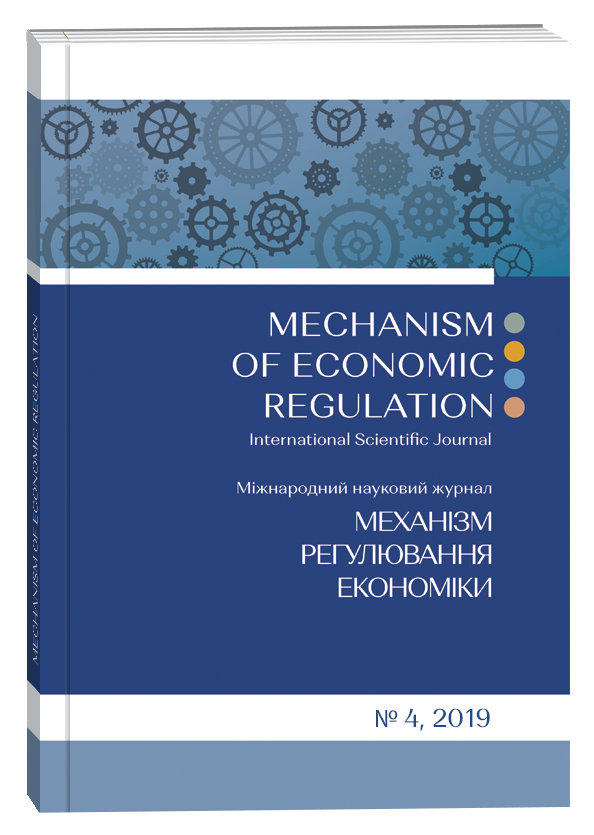ЕЕНЕРГЕТИЧНІ РОЗРИВИ: БІБЛІОМЕТРИЧНИЙ АНАЛІЗ
Анотація
У статті визначено основні наукові напрями дослідження енергетичних розривів з метою виявлення основних детермінант, що впливають на їх величину. Для аналізу автором використано програмне забезпечення VOSviewer та внутрішні інструменти аналізу наукометричної бази даних Scopus. У статті розглянуто статті, що опубліковані у період з 1991 по 2019 роки та індексуються наукометричними базаами даних Scopus та Web of Science. Результати використання інструментів аналізу наукометричної бази даних Scopus показали, що в 2014 році кількість наукових статей, присвячених дослідженню енергетичних розривів, почала збільшуватися. При цьому найбільша кількість статей було опубліковано вченими з США, Китаю та Індії. У той же час, найчастіше дослідження питань енергетичних розривів було профінансовано Національним фондом природознавства Китаю та Міністерством енергетики США. Слід відмітити, що статті щодо аналізу енергетичних розривів опубліковано у таких високо рейтингових журналах як: Journal of Economic Perspectives, Economic Modelling, Functional Ecology. Отримані результати показали, що тема енергетичного розриву корелює з сучасними тенденціями поширення питань сталого розвитку та зеленої енергетики. Дані VOSviewer дозволили виокремити 8 кластерів масиву наукових статей, які досліджували енергетичні розриви з різних точок зору. Перший кластер включав такі ключові слова: енергоефективність, енергозбереження, енергоефективність тощо. До третього кластеру увійшли статті, що присвячені аналізу стабільності та зміні клімату. Другий та четвертий кластери були зосереджені на інженерно-технологічних аспектах енергетичних розривів. Третій кластер розташований найближче до першого кластеру, що дає підстави виокремити наступні параметри енергетичного розриву: стійкість; розрив енергоефективності; питома відновних джерел енергії. Така тенденція дозволяє зробити висновок, що енергетичний розрив слід аналізувати з економічної та управлінської точки зору з метою розроблення та впровадження дієвих механізмів та інструментів їх мінімізації. Крім того, результати дослідження дозволили виокремити наступні групи параметрів-впливу на величину енергетичного розриву: технологічні; екологічні; енергоефективності; сталого розвитку.
Посилання
Backlund, S., Thollander, P., Palm, J., & Ottosson, M. (2012). Extending the energy efficiency gap. Energy Policy, 51, 392-396.
Chen, G. Q., Wu, X. D., Guo, J., Meng, J., & Li, C. (2019). Global overview for energy use of the world economy: Household-consumption-based accounting based on the world input-output database (WIOD). Energy Economics, 81, 835-847.
Chirichenko, Y., & Fisunenko, N. (2018). Marketing determinants of the development of the investment market: innovations in the assessment of demand and supply (case study for the construction industry). Marketing and Management of Innovations, 3, 81-94.
Gerarden, T. D., Newell, R. G., & Stavins, R. N. (2017). Assessing the energy-efficiency gap. Journal of Economic Literature, 55(4), 1486-1525.
Hunt, A., & Greenstone, M. (2012). Is There an Energy Efficiency Gap? Journal of Economic Perspectives,26 (1), 3-28.
Ibragimov, Z., Lyeonov, S., & Pimonenko, T. (2019). Green investing for SDGS: EU experience for developing countries. Economic and Social Development: Book of Proceedings, 867-876.
Jaffe, A. B., & Stavins, R. N. (1994). The energy-efficiency gap What does it mean? Energy policy, 22(10), 804-810.
Lyeonov, S., Pimonenko, T., Bilan, Y., Štreimikienė, D., & Mentel, G. (2019). Assessment of Green
Investments’ Impact on Sustainable Development: Linking Gross Domestic Product Per Capita, Greenhouse Gas Emissions and Renewable Energy. Energies, 12(20), 3891.
Nepal, R., al Irsyad, M. I., & Nepal, S. K. (2019). Tourist arrivals, energy consumption and pollutant emissions in a developing economy–implications for sustainable tourism. Tourism Management, 72, 145-154.
Reddy, B. S. (2003). Overcoming the energy efficiency gap in India’s household sector. Energy Policy, 31(11), 1117–1127.doi:10.1016/s0301-4215(02)00220-3
Scott, K., Giesekam, J., Barrett, J., & Owen, A. (2019). Bridging the climate mitigation gap with economy‐wide material productivity. Journal of Industrial Ecology, 23(4), 918-931.
Sotiriou, C., Michopoulos, A., & Zachariadis, T. (2019). On the cost-effectiveness of national economy-wide greenhouse gas emissions abatement measures. Energy policy, 128, 519-529.


